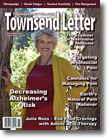|
As naturopathic physicians we have taken an oath that includes the English translation of primum non nocere, that, foremost, we not harm our patients. While we often describe the phrase as a Hippocratic injunction, it isn't a phrase found in the Hippocratic Corpus. Nor is it in the Hippocratic Oath, taken by MDs, although most doctors assume the Oath includes this statement. The closest the Hippocratic Oath comes is the advice "to abstain from doing harm."
There is at least partial agreement among medical historians that this primum injunction was first voiced by the French doctor Auguste Chomel in the early 1800s although some references attribute it to Thomas Syndeham or Thomas Inman. Chomel's Latin version came first and the Thomases apparently only deserve credit for the English translation, which first appeared as 'First do no harm' in 1860. Worthington Hooker is also mentioned in these discussions because he is credited with being the first to employ the phrase in the United States.1,2
 The injunction draws a line between injuring the patient by doing too much and causing harm by not doing enough. This is an important line. The injunction draws a line between injuring the patient by doing too much and causing harm by not doing enough. This is an important line.
While primum non nocere is a common denominator for all physicians, it shines bright upon and illuminates much of what we do as naturopathic physicians, in particular those who focus on naturopathic oncology. There is a fine line between the harm attributed to conventional cancer care and the benefits that result, which is sometimes hard to see; it is sometimes a challenge to discern any advantages from treatments without large studies and subjecting the data to statistical analysis. Without such careful evaluations, clinical benefits of some modern treatments can be hard to ascertain. There is an equally fine line between what we do as naturopathic physicians trying to discern if our therapies provide measurable benefits or not. There is a paucity of data to help us see our way and often we rely on evidence that is relatively weak. We encourage patients to use our therapies because there is a possibility the interventions will help and little reason to suspect they will cause harm. "We have nothing to lose in trying this" is something most of us have said often.
Things being as they are, we pay sharp attention to any evidence that justifies the therapies we suggest, seeking confirmation that they offer patients a chance for a better outcome and that assures us we are not causing harm. The publication of a study by Skylar Johnson and colleagues in the July 18, 2018 issue of JAMA Oncology has justly concerned many of us as it suggests the opposite of what we assumed could be true.3 If Johnson's findings are accurate, some of us should abruptly change the way we practice. The problem is that there are questions about the data employed in Johnson's analysis, enough so that we may have to wait until a newer, better study is published to insist on change.
Johnson's July paper, an earlier version was published in January,4 was a retrospective observational analysis of data obtained from the National Cancer Database on 1,901,815 patients who were diagnosed with non-metastatic breast, prostate, lung, or colorectal cancer between 2004 and 2013. This kind of study is sometimes referred to as data mining.
Johnson's study compared outcomes of 258 patients who had been flagged as utilizing complementary or alternative therapies (CM) against matched controls who did not use CM therapies. Use of complementary medicine (CM) was associated with significantly poorer five-year overall survival compared with no CM (82.2% vs 86.6%; P = .001) and was independently associated with greater risk of death (hazard ratio, 2.08) in a multivariate model. On the face of it, complementary medicine was associated with a worse outcome.
In this research the authors chose to use a definition of complementary medicine that differs from the way it has generally been defined. In Johnson's view, "Complementary medicine (CM) is used in addition to conventional cancer therapy (CCT) and may be used as a substitute for adjuvant therapies."
Most integrative practitioners make a significant distinction between complementary medicine, which is used in addition to standard of care therapies, and alternative medicine, which is used instead of conventional therapies. Johnson sees use of 'complementary therapies' as falling on a continuous spectrum from what we would call complementary to alternative and groups together all practices whether they are used along with or instead of conventional cancer care.
Johnson also defined CM as "unproven cancer treatments administered by nonmedical personnel in addition to at least 1 conventional cancer treatment such as surgery, radiotherapy, chemotherapy and/or hormone therapy." His specification about nonmedical personnel has caused additional confusion as to how we interpret his meanings. Quoting the study, "Our work demonstrates that CM and alternative medicine likely represent entities along a continuum, rather than being distinct entities."
Johnson's lumping complementary and alternative therapies together concerned many of my colleagues as most of us strongly favor complementary or integrative approaches.
The CM patients in this study stand out as particularly non-compliant patients:
- 7% of them refused recommended surgery compared to 0.1% of the control group.
- 34% of them refused chemotherapy compared to 3.2% of the control group.
- 53% refused radiotherapy compared to 2.3% of the control group.
- 33.7% refused hormone therapy compared to 2.8% of the control group.
The use of complementary medicine (Johnson definition) (CM) was associated with increased risk of death when the data was analyzed in total, but if the data was categorized by which patients refused conventional treatment, the associations disappear: "CM (vs no CM) no longer had a statistically significant association with the risk of death (HR, 1.39; 95% CI, 0.83-2.33)."
In other words what Johnson really measured is the effect of poor compliance or not using conventional cancer therapy. Refusing conventional cancer treatment (CCT) was associated with a poorer prognosis. Choosing to use any form of complementary medicine in this group of patients was just a strong predictor of who would refuse conventional treatment. Johnson's conclusion:
…patients who use alternative medicine and CM are often behaving similarly in refusing conventional treatment. As a result, like the patients using alternative medicine (who do not undergo any initial CCT), patients using CM are also placing themselves in an unnecessarily greater risk of death by refusing some CCT....
In Johnson's data use of CM is a measure of whether the patient will be compliant with the treatment suggested by the oncologist. If the patient doesn't do as told, they are twice as likely to die. Is that a surprise?
Sadly, this conclusion is believable and many of us who practice naturopathic oncology have seen noncompliant patients do poorly over the years. While most of our patients are pragmatic and want to do whatever it takes to get better, there are some who come to the office adamant that they will not 'submit' to standard therapies and insist on a particular treatment they believe offers cure. Perhaps Johnson's work might be an argument for integrative oncology over alternative oncology? In other words, perhaps it is time for us to argue stronger to get patients to follow the standard of care? This could pose a challenge for the many patients who believe what they have 'researched on the internet' and believe in the big pharma cancer treatment conspiracies.
People acquire inaccurate beliefs about cancer and natural cures from a multitude of sources and opt for all sorts of 'belief-based treatments' over evidence-based therapies in combination with evidence-informed natural medicine. One may think the ready access to information on the internet would lessen this problem but instead we have entered a 'post truth' era, where facts seems to matter less and this problem of websites promoting miracle cures seems to only be worsening.
The central message of Johnson's article is clear: patients with cancer who refuse proven, standard-of-care cancer treatments have worse overall prognosis and survival. The study doesn't tell us what complementary therapies do.
You'll have noticed that I keep predicating my statements, "If Johnson is correct." That's because his data do not quite add up.
As mentioned the authors mined their data from the National Cancer Database starting with 1,901,815 patients. That's just short of two million people. Out of these nearly 2 million people, they found just 258 people who met their study criteria.
 Numerous published estimates suggest relatively high percentages of cancer patients chose to incorporate some form of alternative or complementary medicine into their cancer treatment. A 1998 review by Cassilith reported a high of 64% and a low of 7%.5,6 The NIH suggests that 30% of adults and 12% of kids with cancer are engaged in non-conventional cancer therapies.7 More recent estimates suggest utilization of CAM therapies by cancer patients is anywhere between 25% and 84% and that this varies by part of the country and type of cancer.8-16 Numerous published estimates suggest relatively high percentages of cancer patients chose to incorporate some form of alternative or complementary medicine into their cancer treatment. A 1998 review by Cassilith reported a high of 64% and a low of 7%.5,6 The NIH suggests that 30% of adults and 12% of kids with cancer are engaged in non-conventional cancer therapies.7 More recent estimates suggest utilization of CAM therapies by cancer patients is anywhere between 25% and 84% and that this varies by part of the country and type of cancer.8-16
Yet in Johnson's data, only 258 cases out of nearly 1,901,815 patients met the inclusion criteria. This calculates to less than 0.01% of the original cohort. Even if we take the NIH's conservative estimate that only 30% of adults with cancer engage in CAM practices, there should have been about half a million patients who qualified; the incredibly low number of people meeting the study criteria rings an alarm. The numbers are off by four decimal points of where they should be. There should have been far more study participants. If we conservatively estimate that half of cancer patients engage in some alternative medical practice, we would expect nearly a million patients to have qualified for analysis. Something about the selection methods used by Johnson et al, did not work. Knowing this, we are forced to question all of their conclusions.
The other problem with this study is that the results made for good headlines and the news media these days is driven more by what attracts the public's attention than what is good information. Even the New York Times found the temptation too great and made the best of it using the headline: "Alternative Cancer Treatments May Be Bad for Your Health: People who used herbs, acupuncture and other complementary treatments tended to die earlier than those who didn't."
The Times author does point out that, "The complementary treatments did no harm when conventional treatment was carried out simultaneously."17 But with the leading headline in larger font, few readers will notice such a qualification.
As is often the case, negative studies get the most attention. We do not see the same amount of coverage for studies with positive outcomes.
The Times missed writing about Eran Ben Arya's 2015 paper that reported that complementary medicine along with chemotherapy improved fatigue and the quality of life of women being treated for gynecological cancer.18 Nor was there mention of Jill Johnson's 2014 paper that reported complementary medicines in an oncology setting reduced pain and anxiety.19 or other papers that encourage us that what we are doing is helpful.20,21 A PubMed search for published clinical trials on complementary medicine and cancer from the first of this year to my writing this in mid-August yields 121 citations. There is a great deal of good research that is just not making the news.
There are some patients who acquire a strongly-held belief that a "non-toxic" or "natural" approach to treating cancer is superior to conventional approaches presented by their oncologist. Johnson's results probably should encourage all of us who care for cancer patients to encourage patient to seek integrative or complementary care rather than to pursue purely alternative treatments in lieu of conventional care. The data would do so quite strongly, if only there wasn't a question about those numbers. It's all about the primum non nocere business.
References .pdf
Dr Jacob Schor, ND, FABNO has practiced as a naturopathic doctor in Denver, Colorado since 1991. He is past president of the Colorado's professional association for naturopathic doctors (CoAND) and the Oncology Association of Naturopathic Doctors. He is a frequent contributor to the Townsend Letter.
drjacobschor1@msn.com
|
![]()
![]()
![]()







